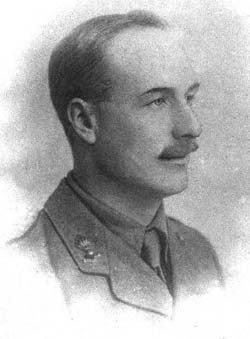
From the Thorley Archives
Thorley Men at Gallipoli
April 25th 2005 is the 90th anniversary of the Gallipoli Campaign. Thorley was represented in this ill-fated chapter of the First World War by Charles Clark M.C. and George Brewster. According to our Rector at the time, Canon J.E.I. Procter, Lieutenant Clark 'was one of the first to land and almost last to leave'. Private Brewster, on the other hand, 'went out to Gallipoli August 1st 1915.'
As First Lord of the Admiralty, Winston Churchill deployed Allied troops, mainly from Britain, Australia and New Zealand, to relieve the pressure on Imperial Russia from the Turkish forces and thereby gain access to the Black Sea ports via the Dardanelles. Landings took place at Helles and Anzac Bays on 25th April 1915 and later at Sulva Bay in August 1915. The invasion forces were severely restricted to a narrow beachhead and progress inland was halted by superior Turkish positions and fortifications. With little chance of breaking the stalemate and having sustained over 250,000 casualties, the withdrawal from the Gallipoli Peninsula was completed by January 1916.
"The Gallipoli Peninsular is only 10 miles at the widest point, and is about 45 miles long. Cape Helles lies at the southernmost tip. The terrain is inhospitable: it is a rocky, scrub-covered area with little water. The hills are steep-sided and are cut into deep ravines. Conditions on Gallipoli defied description. The terrain and close fighting did not allow for the dead to be buried. Flies and other vermin flourished in the heat, which caused epidemic diseases. Of the British casualties, more than half were due to sickness; chief causes being dysentery, diarrhoea, and enteric fever." - from a contemporary report.
 |
|
|
The Royal Artillery Badge
|
Charles Clark was one of four sons of James and Jane Clark of Moor Hall Cottages, Thorley. He was born in 1886 and after attending Thorley School chose, at the age of sixteen, to join The Royal Horse Artillery. Having served in South Africa and India, Sergeant Clark returned to England in January 1915. He was subsequently commissioned and, as Lieutenant Clark, landed with the first wave of the Lancashire Fusiliers at Cape Helles. It was here that he earned the Military Cross 'for fixing wires and getting a message back to the Battery and Headquarters some hours before the next quickest message got through'. No doubt he performed the repair of the telephone cables whilst under heavy fire from the Turkish troops. Eight months later he was evacuated from Gallipoli and returned to England. Rapid promotion to Major followed through tours of duty in the French trenches. Exactly three years from his landing in Gallipoli, Major Clark was killed on 25th April 1918 at Bienvilliers-au-Bois commanding his artillery battery. He is buried in the Bienvilliers Military Cemetery, Pas de Calais, France.
|
|
|
|
The Wiltshire Regimental Badge
|
George Cornelius Brewster was born in 1890, the son of Charles and Eliza Brewster of Thorley Street. Before joining the army, in September 1914, he was chauffeur and gardener to a Doctor Revill of Woodford, Essex. His 5th Battalion of the Wiltshire Regiment had landed at Cape Helles in July 1915 as part of an offensive to break the stalemate and to seize the hills and high ground that controlled the Dardanelles Straits. Private Brewster's unit formed part of the reinforcements that landed on August 1st 1915. He was amongst the many wounded when his battalion suffered heavy losses on 29th August. After being treated locally he was transferred to a hospital ship and taken to Cairo. George Brewster died of his wounds, aged 25, on 25th September 1915 and was buried in the Cairo War Memorial Cemetery. At a memorial service held at St James, Canon Proctor referred to Private Clark's 'manly Christian character and to the esteem in which he was held by all who knew him'
Much of this material is drawn from an article written in 2003 for the Gallipoli Association, by Norman Smith, a member of our St. James' congregation.
Bill Hardy
April 2005